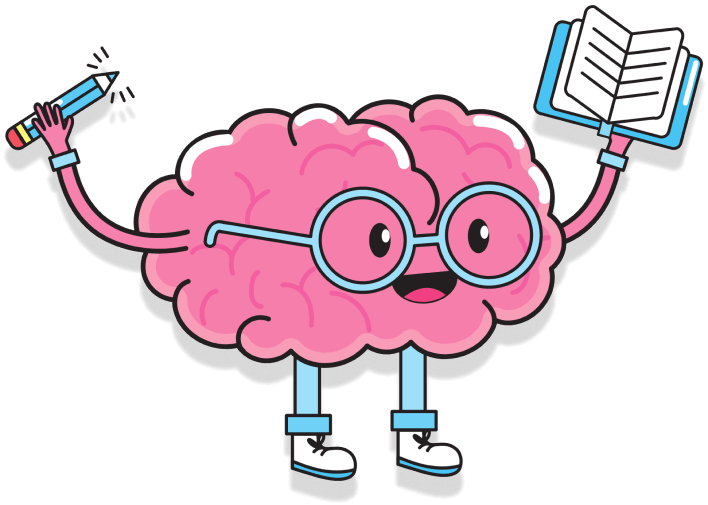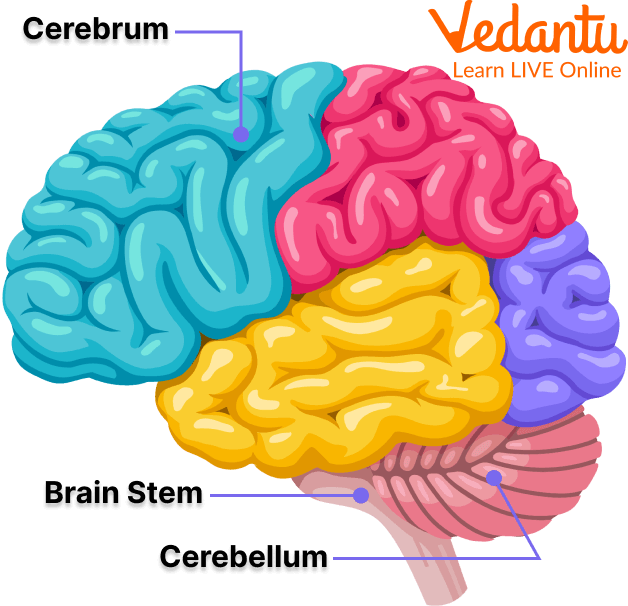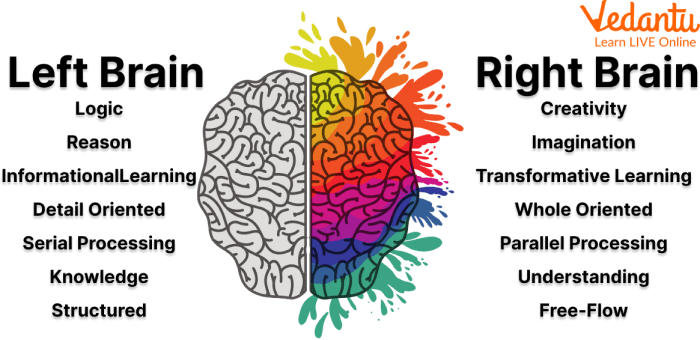




Introduction to Brain for Kids
Human brains are among the most complex parts of the body. It is the most complex organ in the human body, and it is also the most important. It controls everything we do, from breathing and heart rate to thinking and feeling. It is made up of many different parts, each with a specific function. In this article, we will introduce you to the parts of the brain for kids and explain how the brain works for kids. We will also provide some brain facts for kids to learn more about this amazing organ! Below is the graphical representation of the brain diagram for kids.

Brain Diagram for Kids
Different Parts of the Brain for Kids
Your brain is made up of several separate sections that all operate together. We'll go over these three parts, which are crucial players on the brain team. Following are the parts of the brain for kids:
Cerebrum: The cerebrum is the largest portion of the brain. The cerebrum is the brain's thinking component, and it controls your voluntary muscles, which move when you want them to. So, to dance or kick a soccer ball, you need your cerebrum.
You need your brain to solve math problems, play video games, and draw pictures. The cerebrum is where your memory resides, both short-term memory (what you ate for dinner last night) and long-term memory (the name of that roller-coaster you rode on two summers ago).
The cerebrum is divided into two parts, one on each side of the skull. Scientists believe that the right half assists you in thinking about abstract concepts such as music, colours, and shapes.

Different Parts of the Brain Diagram for Kids
The left side is said to be more analytical, aiding you with arithmetic, logic, and communication. Scientists are certain that the cerebrum's right half controls the left side of your body and the cerebrum's left half controls the right side.
Cerebellum: The cerebellum comes next. The cerebellum is located near the back of the brain, just beneath the cerebrum. It is significantly smaller than the cerebrum. However, it is a very crucial portion of the brain. It is in charge of balance, movement, and coordination (how your muscles work together).
You can stand straight, preserve your balance, and move about because of your cerebellum.
Brain Stem: The brain stem is another small but powerful brain region. The brain stem is located beneath the cerebrum and ahead of the cerebellum. It links the rest of your brain to your spinal cord, which goes down your neck and back. The brain stem is in charge of all of your body's vital activities, such as breathing, digesting food, and circulating blood.
The brain stem's job includes controlling your involuntary muscles, which work without your conscious awareness. The heart and stomach have involuntary muscles, and it's the brain stem that signals your heart to pump more blood while biking or your stomach to start digesting your lunch.

Right and Left Brain Explanation
How does the Brain Work for Kids?
The brain sends and receives chemical and electrical impulses throughout the body. Distinct impulses govern different processes, and your brain understands them all. Some cause fatigue, while others cause pain.
Some messages are preserved within the brain, while others are sent through the spine and over the body's enormous network of nerves to distant extremities. The central nervous system uses billions of neurons to accomplish this (nerve cells).
Brain Facts for Kids
Sixty percent of the human brain is made of fat.
Your brain isn't fully formed until age 25.
Brain information travels up to an impressive 268 miles per hour.
The spinal cord is the main source of communication between the body and the brain.
A piece of brain tissue the size of a grain of sand contains 100,000 neurons and 1 billion synapses.
Summary
The brain is a complex organ that controls many important functions of the body. It is made up of many different parts, each of which has a specific job to do. The brain is responsible for thoughts, feelings, movement, and sensation. It is also responsible for controlling the body's vital functions, such as heart rate, blood pressure, and respiration. In the article, we have gone through 3 different parts of the brain and what it is. Then we learned how the brain works for kids and some facts about the brain for kids. The brain is a vast topic, if you have any questions, do ask them in the comments section.
FAQs on Brain for Kids
1. What is the brain in very simple words for a child?
Think of your brain as the super-smart boss inside your head. It's in charge of everything you do, from thinking and feeling to jumping and playing. It helps you learn new things, remember your favourite cartoons, and dream at night.
2. What are the main jobs of the brain?
The brain has many important jobs! Its main functions are to:
- Help you think: It lets you solve puzzles, ask questions, and be creative.
- Control your movements: It tells your legs to run and your hands to draw.
- Manage your feelings: It's where you feel happy, sad, or excited.
- Store memories: It works like a photo album for everything you learn and experience.
3. How does my brain help me learn new things, like reading a book?
Every time you learn something new, your brain builds tiny new connections, like building a new road. The more you practise reading, the stronger that road becomes. This is how your brain gets smarter and stronger, making it easier to remember letters and understand stories next time.
4. What are some fun and easy ways to keep my brain healthy?
Keeping your brain in top shape is fun! You can:
- Eat 'brain food': Foods like fruits, vegetables, and fish give your brain energy.
- Play and exercise: Running around helps send more oxygen to your brain.
- Do puzzles and read: These activities are like a workout for your brain.
- Get lots of sleep: Sleeping gives your brain time to rest and sort all the information from the day.
5. Does my brain go to sleep when I do?
That's a great question! Your brain never fully sleeps. When you are asleep, it's busy working hard. It helps file away your memories, rests your body, and gets you ready for a new day of learning and playing. It's also the part of you that creates dreams.
6. Why is eating healthy food so important for my brain?
Healthy food is like fuel for your brain. Just like a car needs petrol to go, your brain needs nutrients from good food to think clearly, focus in class, and have enough energy to play. Eating colourful fruits and vegetables helps protect it and keep it working at its best.
7. What colour is the brain really?
While you might see it as grey in pictures, a living, working brain is actually a mix of colours. It looks mostly pinkish-brown because of the many tiny blood vessels that carry blood and oxygen to it. It also has parts that are grey and white inside.









